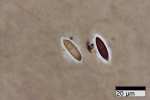|







|
Rosellinia mycophila (FR;: Fr;) Sacc.
Stromata usually densely gregarious, uniperitheciate, rarely fused
together in a 2-3- peritheciate stroma, dark brown to black with a thin coating
of pale subicular hyphae, subglobose with a broadly attached base, 0.6-0.7 mm
high x 0.8-1 mm diam, with conspicuous folds and ridges in the lower part
when dry; ectostroma rather thin, brittle; subiculum densely felted, purplish brown,
of finely interwoven hyphae, persistent, widely spreading.
Ostioles stout, broadly conical, darker than the stromatal wall.
Asci cylindrical, with apical apparatus urn-shaped with
attenuated base, amyloid, 5.5-6 Ám high x 4.5-4.8 Ám broad.
Ascospores 17-21 x 5.5-6.5 Ám, ellipsoid-inequilateral with one
end slightly pinched, the opposite narrowly rounded with an inconspicuous cellular
appendage 2 Ám long, dark brown, with a short, straight germ slit 8-13 Ám long
on the less convex side; the whole spore surrounded by a conspicuous slimy sheath
reducing with age.
Anamorph in nature: not seen.
Specimens examined: FRANCE: AriŔge (09): Rimont,
Las Muros, 08 Aug. 1997, JF-97128/2, on twigs and needles of Picea abies,
mixed with R. thelena.
Notes: It was quite by chance that R. mycophila was found on
a twig of Picea abies mixed with other twigs bearing R. thelena. These
two species are fully similar in external appearance, and can only be separated
by microscopical features of ascospores. Ascospores in R. mycophila are
a bit shorter than in R. thelena, with a shorter germ slit, an inconspicuous
blunt cellular appendage and a slimy sheath around the whole spore. Above all,
they lack the distinctive pointed appendages typical of R. thelena and
its var. microspora.
Rosellinia mycophila was reported by Francis (1986) as a severe pathogen
of conifers [under R. minor (von H÷hnel) Francis] in Europe and North
America, and its differences with R. herpotrichoides Hepting & Davidson
discussed. This pathogen activity seems to be an additional difference with
R. thelena, which has only been reported as a primary saprophyte.
|